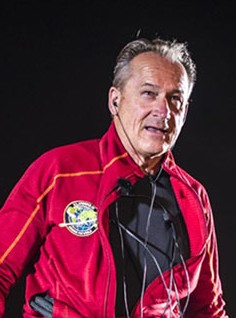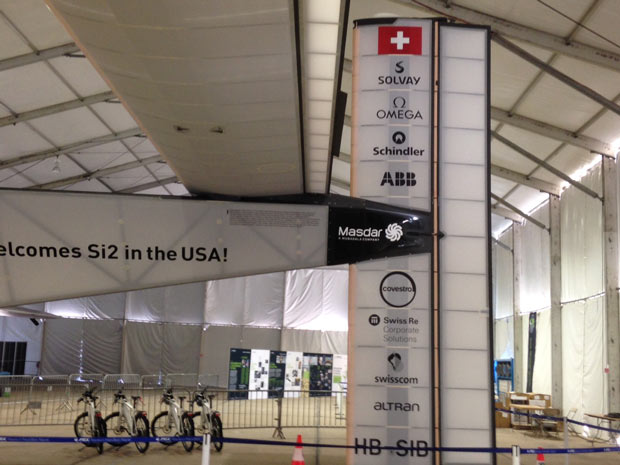
The Solar Impulse 2 successfully landed in Phoenix, Arizona with André Borschberg at the controls, completing the 10th leg of the round-the-world journey. Image courtesy of Solar Impulse SA.
Latest News
May 13, 2016
On Monday. May 9, I had the chance to get within 10 ft. of an engineering marvel designed to inspire the world in the use of clean-energy technologies. With a wingspan of 72 m, (more than that of a Boeing 747) yet the weight of a mid-range SUV, the Solar Impulse 2 is a single-seat, four-engine, solar-powered aircraft. Its design showcases a revolution in advanced materials, lightweight technology and energy efficiency. A critical element of this craft’s development, from the earlier “flying laboratory” version to the current configuration, is the 3DEXPERIENCE platform from official program supporter, Dassault Systèmes.
 The Solar Impulse 2 successfully landed in Phoenix, Arizona with André Borschberg at the controls, completing the 10th leg of the round-the-world journey. Image courtesy of Solar Impulse SA.
The Solar Impulse 2 successfully landed in Phoenix, Arizona with André Borschberg at the controls, completing the 10th leg of the round-the-world journey. Image courtesy of Solar Impulse SA.If you haven’t yet heard about Solar Impulse 2, you are missing the chance to follow history in the making on many technical fronts. And if you do know about the work of the pioneering Swiss designer-entrepreneur-co-pilots Bertrand Piccard and André Borschberg, you’ll want the update of where they are in the midst of their project to circumnavigate the world without a drop of fuel — watch live coverage here.
Piccard is a medical doctor, aeronaut and third-generation world explorer who made the first non-stop balloon flight around the world and envisioned this project in 1999. In 2002, he connected with Borschberg, a jet pilot and entrepreneur who can fly pretty much any plane or helicopter in existence. The two created the Solar Impulse project and have been developing it ever since, now with a team of about 90 members including 30 engineers, 25 technicians and 22 mission controllers.
 André Borschberg, along with co-pilot/explorer Bertrand Piccard, are flying the Solar Impulse 2 around the world on clean technology. Image courtesy of Solar Impulse SA.
André Borschberg, along with co-pilot/explorer Bertrand Piccard, are flying the Solar Impulse 2 around the world on clean technology. Image courtesy of Solar Impulse SA.“This is not a race against the clock. The goal is to demonstrate what is in fact feasible to explore and find ways of doing it,” Borschberg explains. Almost every square inch of the upward-facing surfaces on the Solar Impulse 2 hosts the aircraft’s 17,248 solar cells. These cells, just 135 microns thick, charge the banks of lithium-ion batteries during daylight and serve as the engines’ exclusive power source, supporting continuous day-and-night flying. Spin-off projects might include smaller, unmanned solar-powered craft that could stay aloft for six months, serving as stratosphere-level substitutes for satellites.
In March 2015, Piccard and Borschberg began their current multi-stage, 35,000 km trip, taking off from Abu Dhabi, UAE, and since then have been trading off piloting each leg of the 14-to-16-segment mission. Solar Impulse 2 has already set more than one aeronautical record, as last summer Borschberg flew five days and five nights non-stop from Nagoya, Japan to Oahu, HI.
I had the opportunity to see the aircraft in Phoenix, after its arrival from San Francisco, and to speak with Borschberg about his team’s use of Dassault Systèmes’ design and simulation software. “The first aircraft (piloted across the United States in 2013) was a flying laboratory,” says Borschberg. “Flying day and night had never been done before, and we learned so much.”
 Tail section of the Solar Impulse 2, as it waits in a Phoenix hanger for takeoff to Tulsa, OK. Image courtesy of Pamela Waterman.
Tail section of the Solar Impulse 2, as it waits in a Phoenix hanger for takeoff to Tulsa, OK. Image courtesy of Pamela Waterman.He discussed the challenges of working with composite materials (the aircraft’s wings and fuselage are framed with carbon-fiber ribs) noting that the design, analysis, build and test groups had to work very closely together to get stable results. “Working with Dassault Systèmes, their tools have improved over the past three years and are now really integrated,”Borschberg said. For example, a change in a CATIA CAD model is automatically reflected in a SIMULIA mechanical simulation. “To be able to simulate everything is extremely important.”
“To save weight,” Borschberg noted, “there are very few metallic parts. There is some titanium, and some aluminum on the landing gear.” The lightest layers of carbon weigh just 25 gm/sq meter – one-third the weight of a sheet of paper – yet the aircraft carries a payload of approximately 300 kg.
He adds that the aircraft includes several 3D-printed plastic (via selective laser sintering) parts, “because we are prototyping, changing parts and making just a few [of each part].”
The pilot also explained how the design is an ongoing process, as the team simulates everything from wing shapes to energy usage and tries to measure everything that happens during a flight, with live-monitoring sensors. For example, due to a change in allowed flight plans on the Japan-to-Hawaii segment, the batteries were subjected to unexpectedly high operating temperatures and incurred some damage. However, because every circumstance allows learning and improvement, passive battery ventilation was adding prior to leaving Hawaii.
 Pano-view of left wing and fuselage of Solar Impulse 2 solar-powered single-pilot aircraft. Image courtesy of Pamela Waterman.
Pano-view of left wing and fuselage of Solar Impulse 2 solar-powered single-pilot aircraft. Image courtesy of Pamela Waterman.Putting on his engineering hat, Borschberg is enthusiastic about making aircraft design improvements as supported by the associative Dassault Systèmes’ 3DEXPERIENCE platform, and is anxious to try the company’s latest tools. One product that will be helpful is the new SIMULIA simulation process and optimization framework for creating re-usable, deployable simulation processes in support of design exploration studies. For now, he and Piccard waited for the weather in Phoenix to change, allowing the Solar Impulse 2 to make it to Tulsa, OK, on the way to New York City and the rest of the world.
More Info:
Subscribe to our FREE magazine, FREE email newsletters or both!
Latest News
About the Author
Pamela Waterman worked as Digital Engineering’s contributing editor for two decades. Contact her via .(JavaScript must be enabled to view this email address).
Follow DERelated Topics






